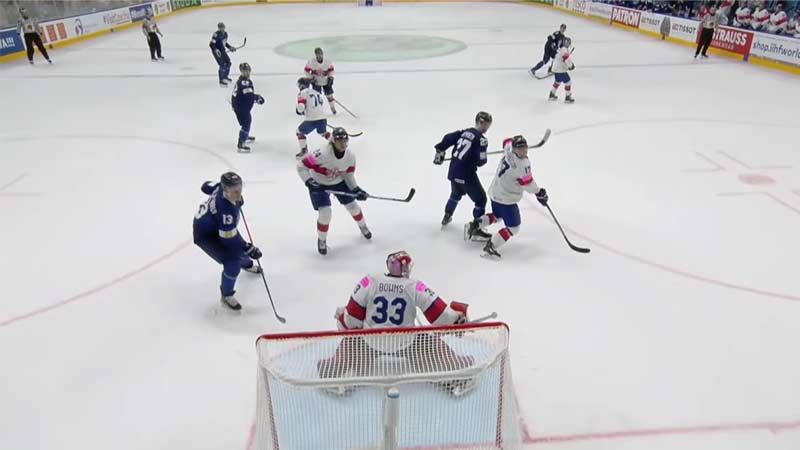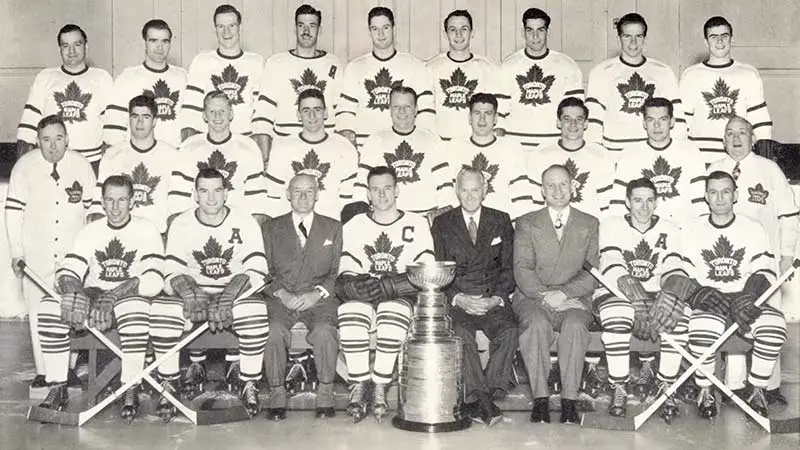The history of ice hockey, a riveting narrative spanning over a century, unfolds as a testament to the enduring spirit and cultural significance of this beloved sport.
Originating in the crisp winters of Canada, the roots of ice hockey dig deep into the 19th century, finding expression in the exhilarating clash of sticks and pucks on frozen surfaces.
The journey began on March 3, 1875, with the inaugural indoor ice hockey game at the Victoria Skating Rink in Montreal, marking the birth of a phenomenon that would captivate hearts across the globe.
From the generous donation of the iconic Stanley Cup in 1892 to the formal establishment of the National Hockey League (NHL) on November 26, 1917, each chapter in the sport’s history unveils tales of skill, rivalry, and international acclaim.
Join us on a historical odyssey through time as we explore the defining moments, legendary players, and cultural impact that have shaped the captivating narrative of ice hockey.
History of Ice Hockey: The Beginning
The origins of ice hockey can be traced back to various forms of stick-and-ball games played on ice in Northern Europe.
While the exact roots of the sport are somewhat debated, it is generally agreed that ice hockey as we know it today has its origins in Canada during the 19th century.
Early Precursors
Before the formalization of ice hockey, there were similar games played in Europe. In the Netherlands, a game called “kolven” involved hitting a ball or puck with a curved wooden stick on the ice.
In England, a game known as “bandy” or “shinny” was played on ice.
Development in Canada
The modern version of ice hockey is believed to have originated in Canada in the early 19th century. British soldiers and immigrants brought their stick-and-ball games to North America, adapting them to the winter conditions.
First Recorded Games
The first recorded indoor ice hockey game took place in Montreal, Canada, on March 3, 1875. The game was played at the Victoria Skating Rink, and it featured two teams of nine players each.
The goals were two wooden posts, and the puck was a wooden disk.
Codification of Rules
The rules of ice hockey began to take shape in the late 19th century. In 1877, the first organized hockey club, the McGill University Hockey Club, was established in Montreal.
The club’s efforts to standardize the rules of the game contributed to its early development.
Introduction of the Puck
The use of a puck, rather than a ball, became common in the late 19th century. The puck’s flat shape made it more suitable for play on ice.
Formation of Leagues
As the popularity of the sport grew, various regional leagues and competitions were established. The Amateur Hockey Association of Canada (AHAC) was formed in 1886, marking an important step in the organization of the sport.
Stanley Cup Era
The Stanley Cup, donated by Lord Stanley of Preston in 1892, became the trophy for the top amateur hockey club in Canada. The first winner of the Stanley Cup was the Montreal Amateur Athletic Association (MAAA) in 1893.
Spread of the Game
Ice hockey spread beyond Canada, gaining popularity in the United States and Europe. The first organized ice hockey game in the United States took place in Baltimore in 1896.
The development of ice hockey continued into the 20th century, with the establishment of professional leagues, international competitions, and the eventual growth of the sport into a global phenomenon.
The history of ice hockey reflects its evolution from informal winter pastimes to a highly organized and competitive sport.
Birth of Modern Ice Hockey

The birth of modern ice hockey can be attributed to several key developments in the late 19th and early 20th centuries, as the sport underwent significant changes in rules, equipment, and organization.
Some of the pivotal moments that contributed to the birth of modern ice hockey include:
Formation of the National Hockey League (NHL)
The National Hockey League, established in 1917, played a crucial role in shaping modern ice hockey. The NHL brought together top professional teams, providing a standardized and competitive platform for the sport.
The league’s formation marked a significant step in the transition from amateur to professional hockey.
Forward Pass Rule
The introduction of the forward pass rule in 1913 was a game-changer. Before this rule change, players could only pass the puck backward.
Allowing forward passes opened up new offensive strategies and increased the speed and fluidity of the game.
Introduction of Goalie Masks
In the early days of hockey, goaltenders played without protective masks. Jacques Plante, a goaltender for the Montreal Canadiens, is credited with popularizing the use of goalie masks in the 1959-60 season.
This innovation significantly improved goaltender safety and changed the game.
Expansion of the Red Line
The addition of the red line, or center red line, in the 1940s, introduced the concept of the two-line pass. This change allowed players to make longer passes, again contributing to a faster and more dynamic style of play.
Integration of European Players
The influx of European players, particularly in the 1970s and 1980s, brought new skills and styles to the NHL.
Players like Bobby Orr, Wayne Gretzky, and Mario Lemieux showcased exceptional talent, influencing the way the game was played and raising its global profile.
Introduction of the Zamboni
The Zamboni ice resurfacer, invented in the 1940s by Frank J. Zamboni, revolutionized the maintenance of ice surfaces.
It allowed for faster and more efficient resurfacing between periods, contributing to better ice conditions and a more consistent playing surface.
Evolution of Equipment
Advances in equipment design and materials have significantly impacted the game. Improvements in skates, sticks, and protective gear have not only enhanced player safety but also influenced playing styles and techniques.
Expansion of Television Coverage
The widespread availability of televised hockey games, especially in the latter half of the 20th century, brought the sport into millions of homes.
Increased visibility led to a surge in popularity and contributed to the globalization of ice hockey.
These developments, among others, have collectively shaped modern ice hockey into the fast-paced, highly skilled, and globally recognized sport that it is today.
The evolution of rules, equipment, and the overall structure of the game has created a dynamic and entertaining experience for players and fans alike.
Spread and Growth of Ice Hockey

The spread and growth of ice hockey have been remarkable, evolving from its Canadian origins to becoming a widely popular sport played and followed globally.
Several key factors have contributed to the expansion of ice hockey over the years:
International Competitions
Early international competitions, such as the Stanley Cup and the Challenge Cup, helped promote the sport beyond Canada.
The participation of teams from the United States and Europe in these competitions contributed to the global interest in ice hockey.
Olympic Games
Ice hockey’s inclusion in the Winter Olympic Games, which began in 1920, significantly contributed to the sport’s global exposure.
The Olympic platform allowed nations from around the world to showcase their talent and competitiveness in ice hockey.
Formation of National Leagues
The establishment of national leagues in various countries has been crucial for the growth of ice hockey.
Leagues like the National Hockey League (NHL) in North America, the Swedish Hockey League (SHL), the Kontinental Hockey League (KHL) in Russia, and others have provided a structured and competitive environment for the development of players and the promotion of the sport.
Expansion of Youth and Amateur Hockey
Grassroots initiatives and the development of youth and amateur hockey programs have played a vital role in introducing the sport to new generations of players.
Many countries now have organized youth leagues, school programs, and community teams that contribute to the growth of the sport at the grassroots level.
Media Coverage and Technology
Increased media coverage, including television broadcasts, streaming services, and online platforms, has made ice hockey more accessible to audiences worldwide.
Technology has played a role in bringing the excitement of the game to fans who may not have access to live events.
Global Competitions
The expansion of international competitions beyond the Olympics, such as the IIHF World Championships, World Junior Championships, and other regional tournaments, has provided additional platforms for countries to showcase their talent and compete on the world stage.
Inclusion in Schools and Universities
The inclusion of ice hockey in school and university sports programs has helped cultivate interest in the sport from a young age.
Educational institutions often serve as breeding grounds for talented players and contribute to the overall growth of the sport.
The combination of these factors has led to the widespread popularity and growth of ice hockey, making it a sport that transcends borders and cultures, with a diverse and passionate fan base around the world.
Establishment of the National Hockey League (NHL)

The National Hockey League (NHL) was established on November 26, 1917, in Montreal, Canada.
The formation of the NHL marked a significant milestone in the history of professional ice hockey and played a crucial role in shaping the modern landscape of the sport.
Here are key events leading to the establishment of the NHL:
NHL’s Predecessor Leagues
Before the NHL, several predecessor leagues laid the groundwork for professional ice hockey.
These leagues included the National Hockey Association (NHA) and its forerunner, the Canadian Hockey Association (CHA). The NHA was formed in 1910 and featured teams in Canada.
Formation of the NHL
The owners of the NHA teams faced internal conflicts, leading to the suspension of the 1917-18 season. Seeking a fresh start and a more stable league, a group of team owners decided to form the National Hockey League.
On November 26, 1917, representatives from the Montreal Canadiens, Montreal Wanderers, Ottawa Senators, and Toronto Arenas (later renamed the Toronto Maple Leafs) met at the Windsor Hotel in Montreal to establish the NHL.
Original Teams
The NHL began its inaugural season with four teams: the Montreal Canadiens, Montreal Wanderers, Ottawa Senators, and Toronto Arenas.
The Quebec Bulldogs were intended to be the fifth team but withdrew before the season started.
Consolidation of Talent
The formation of the NHL allowed for the consolidation of top talent, as it brought together players from the disbanded NHA teams. This contributed to the league’s competitiveness and paved the way for the emergence of star players.
Stanley Cup Agreement
In the early years, the NHL reached an agreement with the Pacific Coast Hockey Association and the Western Canada Hockey League to recognize the winner of the Stanley Cup as the combined champion of these leagues.
This arrangement helped to establish the NHL’s credibility and contributed to the growth of the sport.
Expansion and Stability
The league gradually expanded over the years, adding teams in the United States and Canada. Despite facing financial challenges and labor disputes, the NHL managed to establish itself as the premier professional hockey league.
Introduction of the Forward Pass
In 1929, the NHL introduced the forward pass, allowing players to pass the puck in any direction within the offensive zone. This change in rules further enhanced the speed and excitement of the game.
Great Depression and Expansion Pause
The Great Depression in the 1930s had financial implications for the league, and expansion was put on hold during this period. However, the NHL continued to thrive and gained popularity among fans.
Post-World War II Expansion
After World War II, the NHL experienced a period of expansion, adding new teams and solidifying its status as a major professional sports league in North America.
The NHL’s establishment and subsequent growth have made it one of the most prestigious and widely followed hockey leagues in the world.
Over the decades, the league has expanded, evolved its rules, and become a global showcase for top-tier professional ice hockey talent.
Golden Age of Ice Hockey
The “Golden Age” of ice hockey is a term often used to refer to a period in the history of the sport when it experienced significant growth, popularity, and cultural impact.
While different people may define the Golden Age differently, it generally encompasses several decades during the mid-20th century. Key elements of the Golden Age of ice hockey include:
Original Six Era (1942-1967)
The Original Six era refers to a period in the NHL when the league consisted of only six teams: the Montreal Canadiens, Toronto Maple Leafs, Boston Bruins, Detroit Red Wings, Chicago Blackhawks, and New York Rangers.
This era lasted from the 1942-43 season until the 1966-67 season. During this time, these six teams dominated the league, and rivalries among them became legendary.
Emergence of Hockey Legends
The Golden Age produced some of the greatest players in the history of the sport. Icons like Maurice Richard, Gordie Howe, Jean Beliveau, Bobby Hull, and others became household names and helped elevate the level of play in the NHL.
Dynasties and Championships
The era saw the rise of several dynasties, with certain teams enjoying prolonged periods of success. The Montreal Canadiens, in particular, were highly successful, winning multiple Stanley Cups during this time.
The Detroit Red Wings and Toronto Maple Leafs also had their own periods of dominance.
Innovation and Rule Changes
The Golden Age witnessed various innovations and rule changes that shaped the modern game. Notable among these was the introduction of the red line, allowing for the two-line pass, and the adaptation of goaltender masks for player safety.
Expansion and the Arrival of New Talent
The later part of the Golden Age saw the NHL expand from the Original Six to include new teams. This expansion brought in new talent and helped the league reach new markets.
Cultural Impact and Media Exposure
Ice hockey gained increased cultural significance during the Golden Age, and the sport became more widely covered in the media.
Television broadcasts allowed fans to follow their favorite teams and players, contributing to the growth of the sport’s popularity.
International Success
The Golden Age saw increased international recognition for ice hockey.
The 1956 Winter Olympics in Cortina d’Ampezzo marked the first time that ice hockey was played on a global stage, and Canada, the Soviet Union, and the United States emerged as dominant forces.
End of the Original Six Era
The Original Six era came to an end in 1967 with the addition of six new teams, expanding the NHL and ushering in a new phase of growth and competition.
While the term “Golden Age” often refers to the Original Six era, it’s worth noting that different regions and leagues may have experienced their own golden periods based on local contexts and developments in ice hockey.
Overall, the mid-20th century was a transformative time for the sport, laying the foundation for its continued growth and popularity.
FAQs
When and where was the first recorded indoor ice hockey game played?
The first recorded indoor ice hockey game took place on March 3, 1875, at the Victoria Skating Rink in Montreal, Canada. Two teams of nine players each participated in this historic event, marking an early milestone in the history of the sport.
Who donated the Stanley Cup, and when was it first awarded?
The Stanley Cup was donated by Lord Stanley of Preston in 1892. It was first awarded in 1893 to the Montreal Amateur Athletic Association (MAAA), making it the oldest professional sports trophy in North America.
When did the National Hockey League (NHL) officially form?
The NHL was officially formed on November 26, 1917, in Montreal, Canada. The league’s establishment marked a crucial step in the development of professional ice hockey and laid the foundation for the modern structure of the sport.
Who is credited with popularizing the use of goalie masks in ice hockey?
Jacques Plante, a goaltender for the Montreal Canadiens, is credited with popularizing the use of goalie masks in the 1959-60 season.
Plante’s decision to wear a mask for protection against injuries set a trend that eventually became standard equipment for goaltenders in the sport.
Wrapping Up
In tracing the captivating journey of ice hockey, from its humble beginnings in 19th-century Canada to the global spectacle it is today, we witness the evolution of a sport that encapsulates passion, skill, and cultural significance.
The milestones, legends, and innovations of the game have woven a rich tapestry, marking distinct eras like the Original Six and the Golden Age.
From the historic indoor match in 1875 to the establishment of the NHL and beyond, the history of ice hockey reflects not only athletic prowess but also the enduring spirit that has fueled its enduring popularity across continents.








James Felix